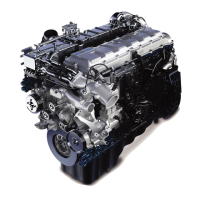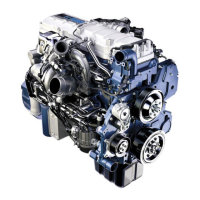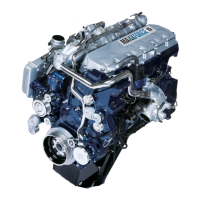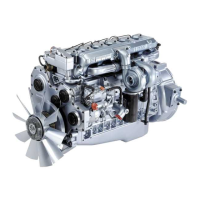
Do you have a question about the Navistar INTERNATIONAL DT 466 and is the answer not in the manual?
| Aspiration | Turbocharged |
|---|---|
| Fuel System | Direct injection |
| Governed Speed | 2600 RPM |
| Displacement | 7.6 liters |
| Horsepower | Up to 300 hp |
| Torque | Up to 860 lb-ft |
| Coolant Capacity | 28 quarts |
| Cooling System | Liquid Cooled |
| Bore x Stroke | 4.59 x 4.68 in (116.6 x 118.9 mm) |
Lists essential requirements for accurate engine diagnosis, including equipment and knowledge.
Lists necessary publications for effective engine diagnosis, such as service and diagnostic manuals.
Defines terms like Warning, Caution, and Note used to emphasize safety instructions.
Provides essential safety guidelines for work area, equipment, vehicle, and engine operations.
Details how to identify engine serial numbers and locate emission labels for DT 466, DT 570, and HT 570 engines.
Explains the components and airflow of the air management system, including turbocharger and EGR.
Covers components of the fuel management system, including ICP and fuel supply systems.
Describes fuel system components and fuel flow, including filter assembly and fuel rail.
Details lubrication system components and oil flow, including oil pump, cooler, and galleries.
Explains cooling system components and coolant flow, including water pump, thermostat, and EGR cooler.
Describes ECM components, operation, function, and control of engine systems like VGT and EGR.
Explains the features and operation of the Diamond Logic® engine brake system.
Lists standard engine features like electronic governor control, ATA Datalink, service diagnostics, and inlet air heater.
Lists optional features such as cruise control, engine fuel pressure monitor, traction control, and engine brake.
Explains how the ECM detects faults and generates diagnostic trouble codes (DTCs).
Details various diagnostic tests like KOEO, KOER, injector disable, and relative compression tests.
Introduces diagnostic test procedures to systematically find and fix engine problems.
Describes how to identify and diagnose combustion leaks into the cooling system.
Explains symptoms, causes, and inspection procedures for aerated fuel in the fuel system.
Details how to diagnose fuel contamination in the engine oil and potential causes.
Covers symptoms and causes of low engine oil pressure and inspection procedures.
Discusses black and white smoke conditions, their causes, and diagnostic procedures.
Explains the purpose of the diagnostic form and troubleshooting approach for hard or no start conditions.
Outlines step-by-step procedures for diagnosing hard start and no start conditions.
Checks for initial system power-up, WAIT TO START lamp, water in fuel lamp, and pre-cycle noises.
Details how to access and interpret Diagnostic Trouble Codes (DTCs) using EST or flashing engine lamps.
Explains the Key-On Engine-Off Standard Test to determine electrical malfunctions via ECM self-test and Output Circuit Check.
Describes how to electronically test fuel injectors by energizing them in a programmed sequence.
Covers procedures to check fuel pressure and identify aerated fuel using a gauge or spare fuel line.
Provides steps to determine the cause of low Injection Control Pressure that prevents engine starting.
Details testing the Inlet Air Heater assembly for correct operation, including amperage draw and voltage checks.
Explains how diagnostic forms help technicians systematically troubleshoot performance issues.
Outlines various tests to diagnose engine performance issues, covering systems like fuel, air, and electronics.
Explains how to identify and record DTCs related to engine performance problems.
Details how to check for restrictions in the exhaust system that can cause engine performance issues.
Covers procedures to verify if the ICP system is providing adequate hydraulic pressure to the injectors.
Describes how to disable injectors one by one to identify the cause of rough engine idle.
Explains how to determine cylinder compression by measuring crankshaft speed differences.
Details tests to verify the correct operation of intake, exhaust, VGT, and EGR systems.
Provides a manual test to check EBP and MAP changes based on VGT control duty cycles.
Outlines monitoring key engine parameters like boost, fuel pressure, and ICP during a full load test drive.
Identifies the physical locations of various sensors and actuators mounted on the engine and vehicle.
Provides general procedures for diagnosing sensors and actuators, including pin grip inspection.
Offers detailed circuit diagnostics for various electronic control systems, including function diagrams and pin-point tests.
Details the circuit operation and fault detection for the Air Management System, including VGT and EGR.
Explains the circuit operation, fault detection, and DTCs related to the APS/IVS sensor.
Details the function, circuit operation, fault detection, and DTCs for the ICP sensor.
Explains the communication between ECM, IDM, and EGR drive module via CAN 2 datalink.
Explains the EWPS features, operational diagnostics, and DTCs for engine protection.
Describes the function, circuit operation, fault detection, and DTCs for the IAH system.
Details the function, circuit operation, and diagnostics for the VGT actuator.
Lists essential tools and accessories for diagnostics, including EST, interface kits, software, and meters.
Describes the EST used for diagnosing and troubleshooting engine and vehicle problems.
Details the interface cables used to connect the EST to the ECM.
Explains the software used for checking system performance and diagnosing problems.
Describes the use of the Fluke 88 DMM for troubleshooting electrical components, sensors, and wiring.
Lists the various breakout harnesses included in the kit for testing sensor and actuator circuits.
Describes the fuel pressure gauge used for checking fuel pressure at the fuel rail.
Covers fundamental electrical theory, Ohm's Law, and proper use of multimeters for testing circuits.
Explains basic electrical concepts like voltage, current, and resistance.
Describes Ohm's Law and its formulas for calculating electrical circuit parameters.
Provides instructions on using a digital multimeter for testing electronic circuits, including specific test meters.
Provides an alphabetical list of common abbreviations and acronyms used throughout the manual for quick reference.
Defines key technical terms and concepts related to engine operation and diagnostics.
A potentiometer sensor indicating accelerator pedal position.
Controls and directs air for engine performance and emissions.
Microprocessor that monitors and controls engine performance, emissions, and vehicle systems.
High lube oil pressure used to actuate fuel injectors and engine brake.
Turbocharger with actuated vanes to control boost pressure and emissions.
Lists performance specifications for DT 466 engines, covering temperature, fuel, and lubrication.
Provides operating temperature ranges, fuel grade recommendations, and oil viscosity for DT 466 engines.
Lists performance specifications for DT 570 engines with standard torque ratings.
Lists performance specifications for HT 570 engines with high torque ratings.
An index of all diagnostic trouble codes (DTCs) with PID, SID, FMI, circuit, and condition description.
Explains that TSI letters provide product enhancements and field service information for technicians.











